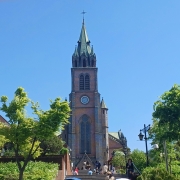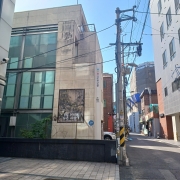There was a pro-democratic resistance movement in 1987. Let’s follow in the footsteps of the Grand Prince’s Office in Namyeong-dong, the Catholic Diocese of Seoul, Myeong-dong Cathedral, and the Lee Han-yeol Memorial Hall. ......Ed
The June Uprising was a large-scale civil protest that occurred across the country in June 1987, calling for democratization. As a result of the June Uprising, the June 29 Declaration was issued, calling for a direct presidential system and a peaceful transition of power. Let’s look back at 1987, an indispensable year in Korea’s history, through the following locations.
Namyeong-dong, an anti-communism Institution (The Democracy and Human Rights Memorial Hall)

“I hit the desk, and he died.”
At that time, “Namyeong-dong” was a symbol of the dictatorship. It was built as an anti-communism investigation center. However, there was a strong perception at the time that it was used as a torture center for democratic activists who opposed the authorities during the military dictatorship. The Namyeong-dong, an anti communism Institution became known for the torture death of Park Jong-cheol on January 14, 1987. The Namyeong-dong, an anti-communism Institution is currently being transformed into “The Democracy and Human Rights Memorial Hall,” which is scheduled to be completed in 2024.
Myeong-dong Cathedral

“The truth on the military torture death of the late Park Jong-cheol was covered up and manipulated...” Time seems to stand still in this brick cathedral at the end of Myeong-dong Alley. It was crowded with excited wedding guests and tourists. Myeong-dong Cathedral, the headquarters of the Seoul Metropolitan Archdiocese, is the first parish in Korea, and is a symbol of the Korean Catholic Church. On May 18, 1987, at a memorial mass for the seventh anniversary of the May 18 Democratic Movement, a priest from the “Catholic Priests’ Association for Justice” revealed the truth about the torture and murder of Park Jong-chul. Myeong-dong Cathedral became the main base of the sit-in.
Lee Han-yeol Memorial

“Put in place a direct election system! Abolish the Constitution! Overthrow the dictatorship!” KOREAN THEATERS PHOTO ESSAY Five minutes from Sinchon Station, among the low buildings, a small plaque of the memorial hangs like a bookmark. The memorial houses memorabilia from Lee Han-yeol’s life, including the clothes and sneakers he was wearing when he collapsed. On June 9, 1987, A tear gas canister struck Lee in the back of the head as he crossed the campus gate. The next day, June 10, a large demonstration organized by the National Movement Headquarters was held in Seoul City Hall Square. The protests continued throughout June. Chun Doo-hwan’s government eventually announced a direct presidential system in the June 29 Declaration. Lee died at 2:05 a.m. on July 5. He was only 20 years old.
The 22nd general election in April was a crossroads for South Korea. Looking back on that June 37 years ago, we take a moment to reconsider the meaning of democracy.
Lee So-young (ST Cub-Reporter)
apricity0302@soongsil.ac.kr


